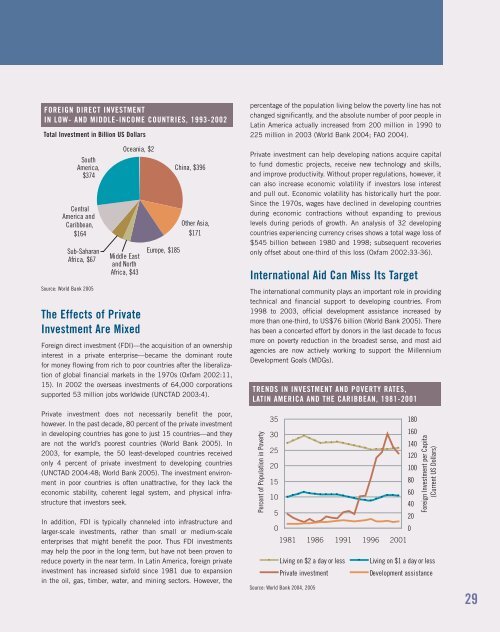jp8589 WRI.qxd - World Resources Institute
jp8589 WRI.qxd - World Resources Institute
jp8589 WRI.qxd - World Resources Institute
You also want an ePaper? Increase the reach of your titles
YUMPU automatically turns print PDFs into web optimized ePapers that Google loves.
FOREIGN DIRECT INVESTMENT<br />
IN LOW- AND MIDDLE-INCOME COUNTRIES, 1993-2002<br />
Total Investment in Billion US Dollars<br />
South<br />
America,<br />
$374<br />
Central<br />
America and<br />
Caribbean,<br />
$164<br />
Sub-Saharan<br />
Africa, $67<br />
Source: <strong>World</strong> Bank 2005<br />
Oceania, $2<br />
Middle East<br />
and North<br />
Africa, $43<br />
The Effects of Private<br />
Investment Are Mixed<br />
Europe, $185<br />
China, $396<br />
Other Asia,<br />
$171<br />
Foreign direct investment (FDI)—the acquisition of an ownership<br />
interest in a private enterprise—became the dominant route<br />
for money flowing from rich to poor countries after the liberalization<br />
of global financial markets in the 1970s (Oxfam 2002:11,<br />
15). In 2002 the overseas investments of 64,000 corporations<br />
supported 53 million jobs worldwide (UNCTAD 2003:4).<br />
Private investment does not necessarily benefit the poor,<br />
however. In the past decade, 80 percent of the private investment<br />
in developing countries has gone to just 15 countries—and they<br />
are not the world’s poorest countries (<strong>World</strong> Bank 2005). In<br />
2003, for example, the 50 least-developed countries received<br />
only 4 percent of private investment to developing countries<br />
(UNCTAD 2004:48; <strong>World</strong> Bank 2005). The investment environment<br />
in poor countries is often unattractive, for they lack the<br />
economic stability, coherent legal system, and physical infrastructure<br />
that investors seek.<br />
In addition, FDI is typically channeled into infrastructure and<br />
larger-scale investments, rather than small or medium-scale<br />
enterprises that might benefit the poor. Thus FDI investments<br />
may help the poor in the long term, but have not been proven to<br />
reduce poverty in the near term. In Latin America, foreign private<br />
investment has increased sixfold since 1981 due to expansion<br />
in the oil, gas, timber, water, and mining sectors. However, the<br />
percentage of the population living below the poverty line has not<br />
changed significantly, and the absolute number of poor people in<br />
Latin America actually increased from 200 million in 1990 to<br />
225 million in 2003 (<strong>World</strong> Bank 2004; FAO 2004).<br />
Private investment can help developing nations acquire capital<br />
to fund domestic projects, receive new technology and skills,<br />
and improve productivity. Without proper regulations, however, it<br />
can also increase economic volatility if investors lose interest<br />
and pull out. Economic volatility has historically hurt the poor.<br />
Since the 1970s, wages have declined in developing countries<br />
during economic contractions without expanding to previous<br />
levels during periods of growth. An analysis of 32 developing<br />
countries experiencing currency crises shows a total wage loss of<br />
$545 billion between 1980 and 1998; subsequent recoveries<br />
only offset about one-third of this loss (Oxfam 2002:33-36).<br />
International Aid Can Miss Its Target<br />
The international community plays an important role in providing<br />
technical and financial support to developing countries. From<br />
1998 to 2003, official development assistance increased by<br />
more than one-third, to US$76 billion (<strong>World</strong> Bank 2005). There<br />
has been a concerted effort by donors in the last decade to focus<br />
more on poverty reduction in the broadest sense, and most aid<br />
agencies are now actively working to support the Millennium<br />
Development Goals (MDGs).<br />
TRENDS IN INVESTMENT AND POVERTY RATES,<br />
LATIN AMERICA AND THE CARIBBEAN, 1981-2001<br />
Percent of Population in Poverty<br />
35<br />
30<br />
25<br />
20<br />
15<br />
10<br />
5<br />
0<br />
1981 1986 1991 1996 2001<br />
Living on $2 a day or less<br />
P rivate investment<br />
Source: <strong>World</strong> Bank 2004, 2005<br />
180<br />
160<br />
140<br />
120<br />
100<br />
80<br />
60<br />
40<br />
20<br />
Living on $1 a day or less<br />
0<br />
Foreign Investment per Capita<br />
(Current US Dollars)<br />
D evelopment assistance<br />
29

















